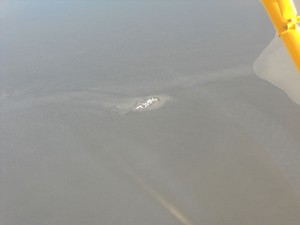
The annual summer effort to determine the number of endangered whales that exist in Cook Inlet is underway with one count completed in June and another finished this month. Christy Sims, a biologist with NOAA has been involved with the annual whale census for more than a decade. The flagging numbers of the belugas makes the count important. As Sims heads across the tarmac for an afternoon aerial survey of Cook Inlet, she says the August count is focused on calves and after several days of capturing video, the real work starts.
“It can take anywhere from three to five months to count it depending on how many groups we encounter. How many passes of video we were able to collect on those groups, based on weather conditions, glare, sun and then some of the video passes have to be dropped due to white caps or glare,” Sims said.
The quarters in the twin engine plane are tight for three scientists and all their camera gear.
The bubble shaped windows on the aircraft aid in the visual count that is compared later to video. The effort to meticulously count the whales is part of the work of documenting their overall status.
Marine biologists and others who have studied the endangered whales are stymied by the declining numbers. Why haven’t the belugas bounced back?
“That’s the $64,000 question. We really don’t know.” Dr. Leslie Cornick said.
Dr. Leslie Cornick is an associate professor of marine biology at Alaska Pacific University. She has researched both Bristol Bay and Cook Inlet belugas. Dr. Cornick studies how the animals sustain themselves in the ocean. She says the prey range of Cook Inlet belugas has contracted to the North.
“Unfortunately for Cook Inlet Beluga whales, really the primary thing that drives where animals choose to be is where their prey is. And for Cook Inlet beluga whales in the summer and fall, their prey is in the upper reaches of Knik Arm and Turnagain Arm, where those really yummy delicious salmon and eulachon runs are,” Cornick said.
This is also where there is more human and industrial activity. The Cook Inlet beluga numbers have hovered around 300 for several years. Lloyd Lowry worked as a marine biologist for the state of Alaska for 25 years. He wonders why a nearby population of Bristol Bay Belugas is doing well while the Cook Inlet belugas continue to suffer.
“It just doesn’t make sense that this many years later there hasn’t been a bounce back in the number of beluga whales. It just doesn’t really make sense,” Lowry said.
He says the Bristol Bay population is thriving at around 2000 whales, and growing at a 5 percent rate per year. He says obvious impacts like ship strikes don’t explain what is happening.
“So that leads you to conclude there are some cryptic things going on, that have to do with the quality of the habitat, the availability of food, the impact of predators and disease, potentially impact of contaminants, disturbance. Those kinds of things that are operating at a much more subtle level are an important part of the picture, it’s not just the obvious mortality that you can quantify,” Lowry said.
Because there has been no subsistence harvest of Cook Inlet beluga since 2005 and that harvest was tightly regulated in 1999, biologists expected the population to increase, but that hasn’t happened. Now potential suspects in Cook Inlet range from low availability of food to industrialization, contaminants from city street run off, airport de-icer and Anchorage’s exemption for secondary treatment of sewage.
Lowry says, so far there hasn’t been high concentrations of contaminants, but tests can’t be taken now. Leslie Cornick agrees that past tests have found the Cook Inlet belugas quite clean of contaminants. But she says changing ocean conditions are key.
“I really like the term global weirding, as opposed to global warming. It’s not about everything just getting warmer, it’s just about everything becoming more chaotic and unpredictable. What does climate change have to do with Cook Inlet Beluga whales? It could have a lot to do with Cook Inlet Beluga whales because it has a lot to do with the health of the ocean. And it’s the health of the ocean, overall, that is really the culprit,” Cornick said.
She says top predators throughout the North Pacific and the Gulf of Alaska are in trouble and they are the canary in the coal mine. Cornick says using the oceans for dumping pits as humans have for thousands of years is taking its toll and for Cook Inlet belugas there isn’t much time.
“That’s actually the thing that worries me, because when you’re dealing with a population that’s only about 300 or so animals, you don’t really have decades and it does concern me that we could see the extinction of this population in my lifetime,” Cornick said.
Tomorrow we’ll look at efforts aimed at helping the belugas recover and the problems that stem from that work.
Listen for the full story
Lori Townsend is the chief editor, senior vice president of journalism and senior host for Alaska Public Media. You can send her news tips and program ideas for Talk of Alaska and Alaska Insight at ltownsend@alaskapublic.org or call 907-550-8452. Read more about Lori here.





